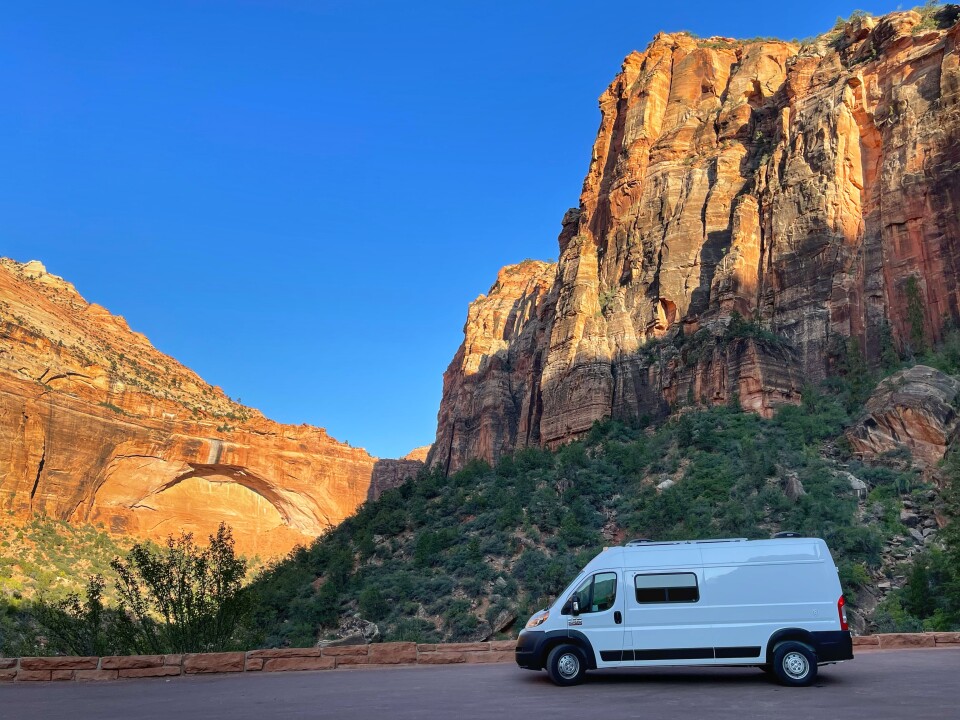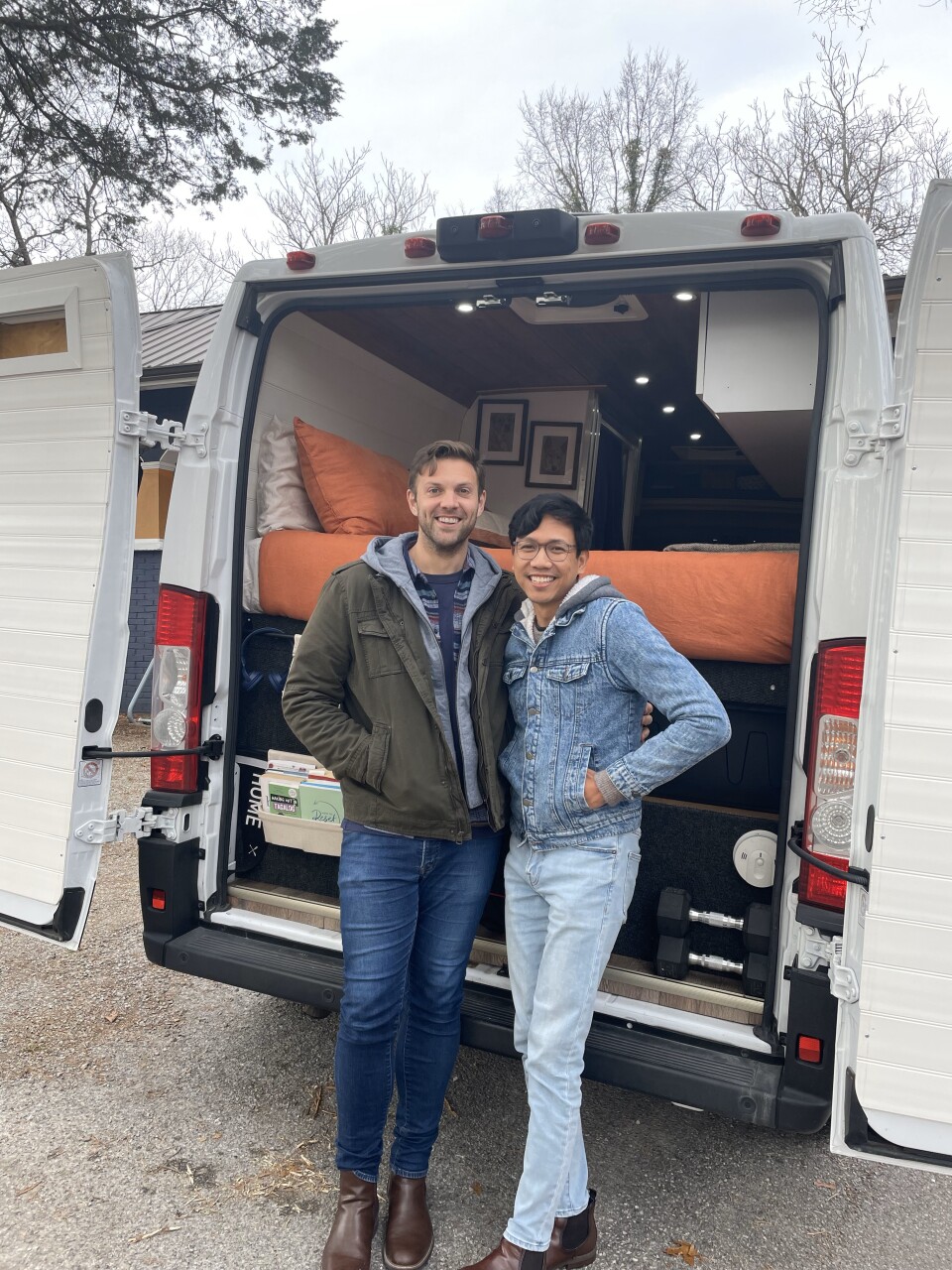Truth matters. Community matters. Your support makes both possible. LAist is one of the few places where news remains independent and free from political and corporate influence. Stand up for truth and for LAist. Make your year-end tax-deductible gift now.
Long live #VanLife! We check in on the movement four years later

In the early days of the pandemic, Angelenos Patrick and Arthur Collera-Ricca were getting ready for a road trip when their vacation rental notified them that due to pandemic restrictions their reservation would have to be canceled.
When the couple realized their weekend trip was a bust, Arthur turned to Patrick and asked, “What about van life?”
“Almost immediately we traded in one of our cars, bought a van, and just without even owning a toolbox, decided ‘Hey, why not try and convert a van yourselves?’” Patrick said.
Patrick and Arthur’s van took almost a year to renovate. During that time, they would take it out on weekends, at times without even having a bed in it.
“It started off as a pandemic project,” said Arthur. “We were inspired and figured we'd want something to keep us busy and start a hobby during the pandemic.”
The #VanLife Movement

Like many others during the pandemic, the couple became interested in the burgeoning movement of #VanLife where people documented their cross-country travels in retrofitted vans on Instagram and YouTube. Some would even share tips and post tutorials to show amateurs how they could convert a van themselves.
Some vans would have full amenities like a kitchen and bathroom, while others were simply a bed thrown in the back.
Beyond just the cool van renovations, #VanLife also showcased the beauty of the outdoors and the potential escapism that traveling to a secluded forest or small mountain town could bring.
Although traveling in decked-out vans was not invented during the pandemic, prior to the #VanLife movement, less than 1% of all RV sales were camper vans, according to Monika Geraci from the RV Industry Association (RVIA). The latest data for 2023 shows that these converted vehicles, categorized under Class B motorhomes for the RVIA, are now 4% of overall RV sales.
“So while they still are a small segment when you're looking at RVing as a whole, they have grown tremendously in popularity,” Geraci said.

For people like Patrick, Arthur and many others, vacationing in a van was a safe way to travel during the pandemic while remaining isolated.
“People wanted to avoid crowded airplanes during that time,” said Jonny Feld, president of Field Van, a company that converts vans into tiny homes, campers, or pretty much anything the customer wants. “But people didn't want to stop living, and they wanted to keep adventuring and traveling.”
The height of #VanLife
For Patrick and Arthur, making the leap into the nomadic life has a lot to do with timing.
Their van conversion was completed in 2022, the same time that their lease was up in L.A. The couple was also working remotely and considering moving somewhere else.
“Why don't we take this opportunity to be actual full time van lifers?” Arthur said. “At that time we considered ourselves as part-timers cause we were taking those long weekend trips for maybe a week at a time. We're like, wait a minute, let's kind of figure this out and see if it could work.”
So, for the next year, Patrick and Arthur and their two dogs lived in the van full-time, traveling cross country twice, including stops at some of their favorite places like the Oregon coast, the small town of Bisbee, Arizona, and of course different spots in California.

Their full-time embrace of van life coincided with the movement’s peak.
According to RVIA's Geraci, some 17,000 camper vans were built in 2022, an increase of more than eight fold from a decade prior. And that number, she noted, does not include other types of vans people can travel in or vans people converted themselves, like Patrick and Arthur's.
This uptick in interest spurred new businesses hoping to cash in on the retrofitted van market.
“We've been building vans since before they were cool,” Feld said. “When they became so popular, you saw a lot of people getting into the van building business.”
But with pandemic-related supply chain issues and COVID exposure hitting some of his employees, Feld said demand soon outpaced supply.
“If I could have predicted it, we would have had 500 vans already built and sitting here ready to go just to support that demand,” Feld said. “When the orders started stacking up, at one point it was like a two year wait list for us because you can only build them so fast.”
At the height of the movement, Patrick and Arthur said converted vans overran national parks and campsites.
“At a certain point, in certain areas, it was hard to find a place to stay, because there were so many people traveling,” said Patrick.
A movement on the decline

As COVID restrictions lifted and employers started to require people to go back to the office, the couple decided it was time to move back to L.A.
Now, they're back to being weekenders and rent out their van to others looking to dip in on the adventure.
Geraci said RV sales as a whole have since plateaued from their peak in 2022. Last year, about 12,000 camper vans were built — still well above pre-pandemic levels.
Whether #VanLife is still as large as it was during the pandemic, its effects on the RV industry seem to be lasting.
“Today's RVer is younger and more diverse than ever before,” said Geraci, adding that the median age for a first time RV buyer is now about 32.
“More people are developing products that can be used in a van or on a van,” said Feld. “Whether it be with the battery systems, like the lithium ion [or] solar.”
Patrick also thinks the movement is still very much alive — just not as a 24/7 lifestyle.
“I don't know that there's less interest," he said. "I think it's just there's now more options again for what a vacation or what a trip looks like.”








